#particularly yellow giy
Explore tagged Tumblr posts
Text
Natural orange 8.40 carat Akik stone GII India certified

The 8.40 carat Akik stone is a rare and beautiful stone from the mines of Afghanistan, it's one of the largest natural Sulemani Akik stones ever mined! The 8.40 Carat Natural Sulemani Akik Gemstone is a durable stone, with a Mohs Scale rating of 8-9. It's resistant to heat and chemicals, so you can wear it every day without worrying about damage. The Sulemani Akik is a deep blue-green color, with a refractive index of 1.72-1.75 and an attractive shape. The stone's proportions are excellent, which means the length and width are in harmony with each other. The value of a gemstone is determined by the grading process, which includes color, clarity and cut. The 8.40 Carat Natural Sulemani Akik Gemstone has a rare dark blue color with high clarity and good cut. The 8.40 Carat Natural Sulemani Akik Gemstone is a geometric shape with an intense color range. It can be used to create pieces that are bold and striking, or subtle and understated. The gemstone's green shades are particularly beautiful when paired with gold or yellow metals, while blue and brown make for a more interesting contrast against silver or white metal designs. Care and Maintenance - Avoid harsh chemicals. - Ultrasonic cleaners are not recommended for this gemstone. - Soap and water is the best way to clean your sulemani akik gemstone. - A soft brush can be used if needed, but avoid using anything abrasive on your gemstone as it may scratch or damage its surface. The Sulemani Akik gemstone is a natural 8.40 carat, greenish-yellow diamond discovered in India in the early 1900s. It was named after its original owner, Suleiman Khan, who was an Indian prince and a friend of Queen Victoria. The stone has been used by Egyptians as far back as 1300 B.C., Hindus during the Mahabharata period (500 B.C.), and Romans during their conquest of Britain (50 A.D.). The Sulemani Akik is a rare and beautiful ruby that was discovered in Afghanistan in the early 1900s. It's believed to have been mined by King Solomon himself, who used it as a talisman of power and wealth. The stone has been rumored to have healing powers as well, but these claims are not substantiated by any scientific evidence. The most famous legend surrounding this gemstone tells of how it was used by kings and queens throughout history--even today's royals still wear them! Read the full article
0 notes
Text
A lil art dump of today's doodles




#DHMIS#Don't Hug Me I'm Scared#My art#yellow guy#red guy#did these instead of important stuff again :'3#kinda proud of how the first one came out tho#the paintbrush i used mimics felt pretty well#been also trying to figure out what style to draw these dudes in#particularly yellow giy#*guy#also me as a puppey
11 notes
·
View notes
Text
I See You

Name: Senegal
Demonym: Senegalese
Etymology: Senegal is translated from the Wolof “sun gal” to mean “our boat”.
Capital: Dakar
Motto: "Un Peuple, Un But, Une Foi" (French)
"One People, One Goal, One Faith"
Location: West Africa
Population: 16,313,742 (2018)
Religion: Islam is the predominant religion in the country, practiced by approximately 94% of the country’s population; the Christian community, at 5% of the population, are mostly Roman Catholics.
Climate: Sahelian
Language(s) Spoken: French and Wolof
National Languages: Balanta-Ganja, Hassaniya Arabic, Jola-Fonyi, Mandinka, Mandjak, Mankanya, Noonm, Pulaar, Serer, Soninke
Currency: CFA franc (XOF)
Independence Day:
- From France 4 April 1960
- Withdrawal from the Mali Federation 20 August 1960
Flag meaning: The red, yellow and green are the official Pan-African colors, and the centered star is symbolic of hope and unity.
Brief History
Archaeological findings throughout the area indicate that Senegal was inhabited in prehistoric times and has been continuously occupied by various ethnic groups.
Some kingdoms were created around the 7th century: Takrur in the 9th century, Namandiru and the Jolof Empire during the 13th and 14th centuries. Eastern Senegal was once part of the Ghana Empire.
Islam was introduced through Toucouleur and Soninke contact with the Almoravid dynasty of the Maghreb, who in turn propagated it with the help of the Almoravids, and Toucouleur allies.
This movement faced resistance from ethnicities of traditional religions, the Serers in particular.
In the 13th and 14th centuries, the area came under the influence of the empires to the east; the Jolof Empire of Senegal was also founded during this time.
In the 14th century the Jolof Empire grew more powerful, having united Cayorand the kingdoms of Baol, Sine, Saloum, Waalo, Futa Tooro and Bambouk, ormuch of present day West Africa.
The empire was a voluntary confederacy of various states rather than an empire built on military conquest.
The empire was founded by Ndiadiane Ndiaye, a part Serer and part Toucouleur, who was able to form a coalition with many ethnicities, but collapsed around 1549 with the defeat and killing of Lele Fouli Fak by Amari Ngone Sobel Fall.
Colonial Era
In the mid-15th century, the Portuguese landed on the Senegal coastline, followed by traders representing other countries, including the French.
Various European powers-Portugal, the Netherlands, and Great Britain-competed for trade in the area from the 15th century onward.
In 1677, France gained control of what had become a minor departure point in the Atlantic slave trade-the island of Gorée next to modern Dakar, used as abase to purchase slaves from the warring chiefdoms on the mainland.
European missionaries introduced Christianity to Senegal and the Casamance in the 19th century.
It was only in the 1850s that the French began to expand onto the Senegalese mainland after they abolished slavery and began promoting an abolitionist doctrine, adding native kingdoms like the Waalo, Cayor, Baol, and Jolof Empire.
French colonists progressively invaded and took over all the kingdoms except Sine and Saloum under Governor Louis Faidherbe.
Senegalese resistance to the French expansion and curtailing of their lucrative slave trade was led in part by Lat-Dior, Damel of Cayor, and Maad a Sinig Kumba Ndoffene Famak Joof, the Maad a Sinig of Sine, resulting in the Battle of Logandème.
Independence (1960)
On April 4, 1959 Senegal and the French Sudan merged to form the Mali Federation, which became fully independent on 20 June 1960, as a result of a transfer of power agreement signed with France on 4 April 1960.
Due to internal political difficulties, the Federation broke up on 20 August, when Senegal and French Sudan each proclaimed independence.
Léopold Sédar Senghor was Senegal's first president in September 1960.
Senghor was a very well-read man, educated in France.
In 1980, President Senghor decided to retire from politics.
Former prime minister Mamadou Dia, who was Senghor's rival, ran for election in 1983 against Diouf, but lost.
Senghor moved to France, where he died at the age of 96.
Senegal joined with the Gambia to form the nominal Senegambia Confederation on 1 February 1982.
Despite peace talks, a southern separatist group in the Casamance region has clashed sporadically with government forces since 1982 in the Casamance conflict.
In the early 21st century, violence has subsided and President Macky Sall heldtalks with rebels in Rome in December 2012.
He encouraged broader political participation, reduced government involve mentin the economy, and widened Senegal's diplomatic engagements, particularly with other developing nations.
Domestic politics on occasion spilled over into street violence, border tensions, and a violent separatist movement in the southern region of the Casamance. Nevertheless, Senegal's commitment to democracy and human rights strengthened.
In the presidential election of 1999, opposition leader Abdoulaye Wade defeated Diouf in an election deemed free and fair by international observers. Senegal experienced its second peaceful transition of power, and its first from one political party to another.
On 30 December 2004 President Wade announced that he would sign a peace treaty with the separatist group in the Casamance region. This, however, has yet to be implemented. There was a round of talks in 2005, but the results have not yet yielded a resolution.
Geography

Senegal is located on the west of the African continent.
It lies between latitudes 12° and 17°N, and longitudes 11° and 18°W. Senegal is externally bounded by the Atlantic Ocean to the west, Mauritania to the north, Mali to the east, and Guinea and Guinea-Bissau to the south; internally it almost completely surrounds The Gambia, namely on the north, east and south, except for Gambia's short Atlantic coastline.
The capital Dakar lies on the Cap-Vert peninsula, the westernmost point of continental Africa.
Culture
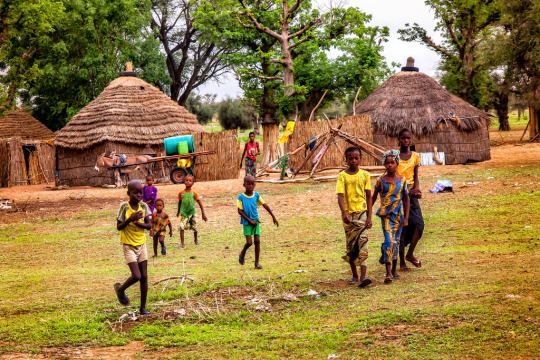
*Wolof village*
Senegal has a wide variety of ethnic groups and, as in most West African countries, several languages are widely spoken.
The Wolof are the largest single ethnic group in Senegal at 43 percent; the Fulaand Toucouleur are the second biggest group, followed by the Serer, the nothers such as Jola, Mandinka, Maures or, Soninke, Bassari and many smaller communities.
About 50,000 Europeans and Lebanese as well as smaller numbers of Mauritanians and Moroccans reside in Senegal, mainly in the cities and some retirees who reside in the resort towns around Mbour.
Also located primarily in urban settings are small Vietnamese communities as well as a growing number of Chinese immigrant traders, each numbering perhaps a few hundred people.
There are also tens of thousands of Mauritanian refugees in Senegal, primarily in the country's north.
According to the World Refugee Survey 2008, published by the U.S. Committee for Refugees and Immigrants, Senegal has a population of refugees and asylum seekers numbering approximately 23,800 in 2007.
Refugees live in N'dioum, Dodel, and small settlements along the Senegal River valley.
SOME WOLOF PHRASES
Welcome
- Merhbe
Hello (General greeting)
- Na nga def (sg)
- Na ngeen def (pl)
- Salaam aleekum
How are you?
- Jaam nga am? (Have you peace?)
- Na nga def?
Reply to 'How are you?'
- Jaam rek, Yow nag? (Peace only, and you?)
- Mangi fi rekk, na nga def?
Long time no see
- Gej na la giis
What's your name?
- Naka-nga sant?
- Na nga tudd?
- Noo tudd?
My name is …
- Maa ngi tudd ...
- ... laa tudd
Where are you from?
- Fan nga joge? (sg)
- Fan ngeen joge? (pl)
I'm from …
- Maa ngi joge ...
- ... laa joge
Pleased to meet you
- Am nàa mbekte ci guiss la
Good morning
(Morning greeting)
- Jaam nga fanane
Good afternoon
(Afternoon greeting)
- Jamm nga yendoo
Good evening
(Evening greeting)
- Naka ngon si
Goodbye
(Parting phrases)
- Ba beneen
- Mangi dem
Good luck!
- Màa ngui lay nianal weurseuk
Cuisine
The basic food is rice cooked with a spicy sauce and vegetables. The national dish is chep-bu-jen,the Wolof word for rice with fish. Cooked in a tomato sauce with boiled fish and a few vegetables (carrots, cabbage, and green peppers),chep-bu-jen is originally from the city of Saint-Louis.Yassa,a dish from Casamance is chicken or fish marinated in lemon juice, pepper, and onions and then baked. It is accompanied by plain white rice. Other sauces include mafé, domada and soupe kandja,(which is made from okra with fish and palm oil).
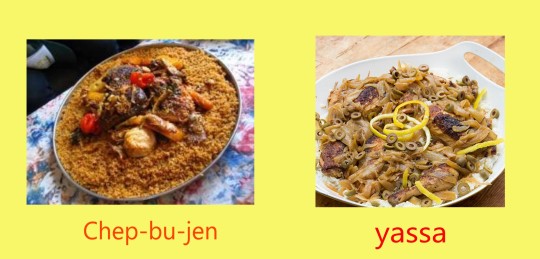
Landmarks
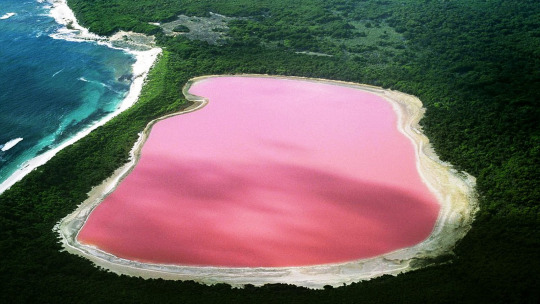
The Lake Retba (Lac Rose meaning Pink lake) - It is named for its pink waters caused by Dunaliella salina algae and is known for its high salt content, up to 40% in some areas.
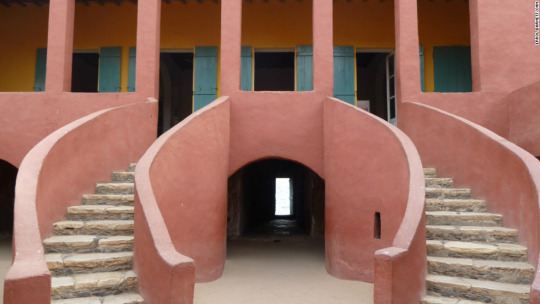
The House of Slaves and its Door of No Return is a museum and memorial to the Atlantic slave trade on Gorée Island, 3 km off the coast of the city of Dakar, Senegal. Its museum, which was opened in 1962 and curated until Boubacar Joseph Ndiaye's death in 2009, is said to memorialize the final exit point of the slaves from Africa.
While historians differ on how many African slaves were actually held in this building, as well as the relative importance of Gorée Island as a point on the Atlantic Slave Trade,visitors from Africa, Europe, and the Americas continue to make it an important place to remember the human toll of African slavery.
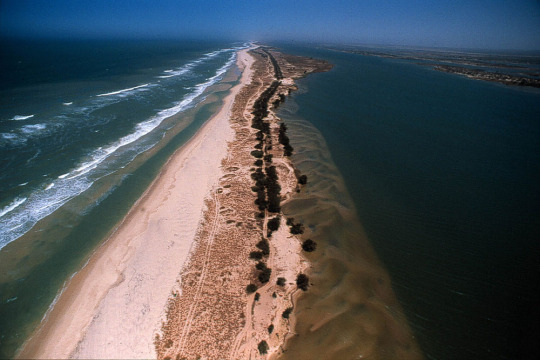
The Langue de Barbarie is a thin, sandy peninsula, adjacent to the Atlantic Ocean, located in western Senegal, in the neighborhood of the city of Saint-Louis. The peninsula separates the ocean from the final section of the Senegal River.

The Great Mosque of Touba is a mosque in Touba, Senegal. It was founded by Amadou Bamba in 1887 and completed in 1963. Bamba died in 1927 and is interred inside the mosque. Since his death the mosque is being controlled by his family.
Some interesting facts about Senegal
1. In the 16th century when the Portuguese visited the country’s coast, the fishermen said “sunu gaal”, which translates into “these are our boats”. The Portuguese, who understood nothing, simply named their land “Senegal”. Classic colonizers!!
2. Senegal’s location towards the west coast made it a hub for the international slave trade of the 18th and 19th century. Gorée Island, in particular, became a major transit point of the Atlantic Slave Trade.
3. In contemporary times, Senegal is very close to France. In fact, the very flag of Senegal has adopted the French Tricolor style. So the flags of both look the same, except for the color
4. Senegal is the only country in West Africa which wasn’t overrun by a military coup. Its democratic stability has earned it many allies in Europe and the Americas.
5. The common lingo of Senegal has a word called, “Teranga”. It has a very sweet and hospitable meaning and has become the identity of Senegalese people. It means helping a person to come to your land and settle down.
6. Dakar is home to the tallest statue in Africa. The African Renaissance Monument built in 2010, stands at an impressive 49 m, but still a meter short of a half-century.
7. Senegal is a paradise for footballers. Many prominent players like El Hadji Diouf, Henri Camara, Ferdinand Coly, Bouna Coundoul, etc. have been inducted into the European League from this country.
8. Senegal’s grasslands have given the country its two national symbols, the baobab tree, and the red lion.
Questions
1. Are you from Senegal or know someone from there?
2. Are you interested in learning Wolof?
3. What’s your favorite thing about Senegal?
4. Do you know anything about Senegal I forgot to mention?
5. Which country/Island do you think I should share about next?
PLEASE INFORM ME IF THERE IS ANY MISTAKE SO I CAN CORRECT IT. THANK YOU :)
*I know I said ISY project is about unknown/less talked about countries but I thought I should share about Senegal since I love it’s people and wanted to know more about their culture.
+ about ISY mini project
+ Previous ISY countries : VANUATU, KYRGYZSTAN .
#I SEE YOU#ISY mini project#SENEGAL#WOLOF#languages#langblr#languageblr#studyblr#history#geography#africa#countries#dakar
3 notes
·
View notes